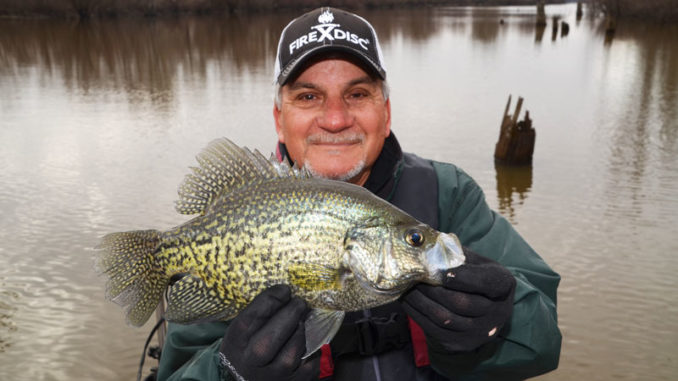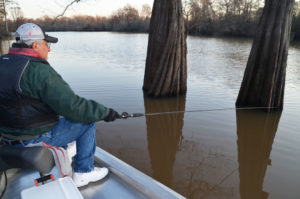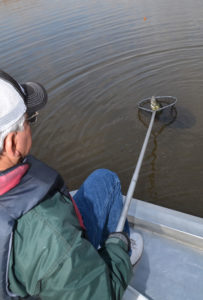
Sac-a-lait in South Louisiana don’t have the luxury of retreating to deep holes to ride out colder temps — but that doesn’t stop Murphy Royer from catching them all winter long.
“Mid-January to mid-February is the toughest time of the year to catch sac-a-lait,” said the dapper 68-year-old retired drug store manager. “The weather gets real cold. I think they may be staging before spawning.
“I wished I knew the answer about why they are so tough to catch.”
Murphy Royer speaks with authority. In the six years since he retired, he fishes four days a week. And he has a specific routine: He fishes for two days, cleans fish on the third, fishes two more days, cleans fish again on the sixth day and then goes to church on Sunday.
This is the routine, 12 months a year. All of it is for crappie, the fish he calls sac-a-lait. And all of it is done with a jig pole — not a rod and reel, and certainly not with a spider rig.

Based from his home in Duson, he concentrates on Henderson Lake, Miller’s Lake, Chicot Lake, Lake Verret, the Bayou Pigeon area of the Atchafalaya Basin, Duck Lake, the Mermentau River and Old River.
His list is a South Louisiana list, which is part of the cold weather problem. North Louisiana reservoirs are noted for having deeper waters that serve as thermal refuges for crappie.
Every winter, the fish head to the same deep holes. Often the water is so deep that when they are reeled up, their air bladders inflate, pushing their stomachs into their mouths and preventing them from submerging, even if released.
The dependability of North Louisiana crappie retreating to deep holes in the dead of winter makes them easy to locate — at least compared to the locations Royer usually targets.
“In South Louisiana, 10 to 15 feet is deep for us. Fish go deep here in the winter, but not always,” he said. “I’ve caught fish here in January jigging trees in 6 feet of water.

“In South Louisiana, fish don’t get deep and stay deep. Here, they move as shallow as 2 or 3 feet when we get 60- or 70-degree weather for a number of days.
“Things seem to be changing the last four or five years. It used to be that the fishing was so hard in January that you didn’t fish for sac-a-lait. Recently, I caught some males in spawning colors at railroad bridge pilings in December in 14 feet of water,” he said, still baffled.
“It’s hard to believe that they are spawning there.
“Of course,” he admitted, “it may be that I’m seeing these things because I now fish four days a week since I retired.
“Here’s my seasonal theory for South Louisiana sac-a-lait: They feed heavily in October, November and December to fatten up for the spawn.
“Then in January and early February, they move deeper to stage up before the spawn. In later February and in March, they spawn next to trees in 3 feet of water. The males will be fat at the beginning of the spawn, and skinny at the end.”
Finding sac-a-lait

Catching fish that aren’t there is impossible. Without the deepwater refuges that exist in North Louisiana reservoirs, finding mid-winter crappie in South Louisiana definitely can be challenging.
Although Royer caught all his crappie on trees standing in water on the miserably cold, dreary winter day we went, he was quick to recommend that finding pilings in deep water is “the key.” (Deep water to him is 8 feet or deeper.)
“Most of the time I will tight-line them, but I have caught them on pilings under a cork in warmer (for mid-winter) weather.”
There is nothing magical about railroad or bridge pilings for Royer. He simply hits them because in many places, trees are seldom found standing in water. Royer likes wood best, but will readily fish concrete pilings.
Brush piles in deep water are productive, he quickly admits, but you need electronics to find them. “I don’t build them myself. They are too much work, and anyone else with electronics can easily find and fish them.”
But even in winter, he will occasionally hit lay-downs. Strangely, he will begin working on one near the bank and fish the trunk out into deeper water.
And his most important rule: “I always try live cypress trees that stand in the water out from the bank. I mean trees, not stumps.”
As for defining deep — “It’s entirely relevant to the lake,” he said a little impatiently, as if his message hadn’t already gotten across. “I love to fish Miller’s Lake (in Avoyelles Parish) and I go as often as I can when the lake opens to fishing about mid-January. It deepest spot is only 5 ½ feet deep.”
Royer’s tactical tips for winter crappie fishing

Murphy Royer is part of a charmed fraternity of South Louisiana crappie tournament fishermen. Operating out of a custom-welded-for-crappie aluminum boat, Royer scours South-Central Louisiana for the delicious table fish. Everyone in the fraternity knows everyone else. All have opinions built on years of success.
These are Royer’s:
- When fishing bridge pilings, fish as close as possible to each piling. Royer will often semi-wrap his line around the piling and jig it so that it drags on the piling’s surface.
- Royer doesn’t change the tempo at which he works his jigs to adjust for the fish reacting slower in cold water. “I jig just as fast as in the spring or summer,” he stated confidently.
- Simply because it is awkward to use a cork at depths over 4 feet and because the fish are generally deeper in the winter, Royer tight-lines more now than at other times of the year. It is slower, he cautioned, and demands a lot of feel, since there is no cork to provide visual cues.
- His color tactics are the same as in the summer, but he stressed that color is very important when the fish are feeding slowly in the winter. Dominant colors in his hair jigs are olive, chartreuse, orange, red, silver and blue. “Try colors until you find the color they like that day, then use it,” he urged.
- Although Royer uses both 1/16- and 1/32-ounce jigheads year round, he uses more 1/32 in the winter because the weight isn’t needed to penetrate the grass mats commonly found in summer.
- Royer pushes to get on the water early, even on the coldest of days. And surprisingly, he doesn’t believe that warming water temperatures that come with the rising sun produce better fishing in the winter. “I always do best early and mid-morning,” he said firmly.
- While Royer doesn’t use live shiners himself, he recommends them to others for winter fishing. “They have a lot of ability to attract fish because they stay lively so long in cold weather.”
- Royer emphasized that electronics are not needed to fish South Louisiana’s shallow waters successfully for crappie. “Electronics cost a lot,” he said. “You can spend $10,000 — and they break a lot. If I was dropped in a strange place to sac-a-lait fish, the first thing I would look for is visible structure,” which he defined as trees, stumps and pilings of any sort. “I did a personal count two years ago and caught 5,000 fish in one year — all without electronics.”
- “Change your expectations as to water color,” Royer said. “In the summer, you need clarity. I prefer to be able to see my jig 6 to 8 inches down. In the winter, I can catch fish in waters where my jig is only visible 2 or 3 inches down.”
- As for attractants like crappie nibbles, Royer claims to be “old school.” He cracked dryly, “A ton of people believe in them, but I think they are not worth the trouble.”
- Royer is a stickler for setting up a boat for maximum efficiency. He sits on a low pedestal seat on the bow with a hole built into the bow deck to accommodate an ice chest. He can open the chest without moving from his seat or even stooping. At his fingertips he has a very long-handled dip net that he can grab without moving. Beside the dip net, he always carries eight pre-rigged jig poles. Changing jig colors or going from tight-line to cork fishing is simply a matter of grabbing another rod, rather than having to stop and re-rig.
- Preferred barometric conditions are between 29.30 and 29.24 inches. His preference is for it to be moving: Either rising or falling is good.
- “South winds are the best for sac-a-lait fishing; north winds are the worst,” he clipped. “Water temperatures of 60º F and above are best. For air temperatures, the warmer, the better.”
Tip of the day

Good crappie fishermen need to have a good memory.
“For some reason, the same individual tree will hold sac-a-lait at the same time of the year — every year. I don’t know if it’s the smell or what,” Royer laughed. “But remember those trees.”